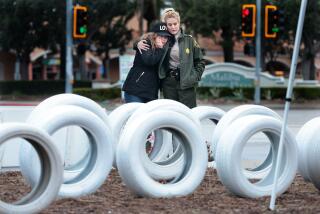Freeway ‘Gawk Screens’ Designed to Put Drivers’ Eyes Back on Road : Transportation: Caltrans spending $500,000 to provide masked turnouts on the 10 where stalled cars can be removed from traffic and accident victims can exchange information.
- Share via
WESTSIDE — What are those mysterious little turnouts being built along the fringes of the Santa Monica Freeway?
Freshly paved, and soon to be masked by “gawk screens” to fight the morbid fascination of motorists, they are accident investigation sites, the first of their kind in California.
With a dozen of them scattered between the San Diego and Harbor Freeways, the $500,000 Caltrans experiment is supposed to help traffic flow along the nation’s busiest stretch of freeway. They will be lighted at night and equipped with pay phones, call boxes, water spigots and identifying signs.
“It’s just a little area . . . where people can pull off and exchange information rather than stop in freeway lanes and block traffic,” said Russell Snyder, a spokesman for the state transportation department.
“We can’t stress it enough, and it’s very important, that it can be very dangerous anywhere you’ve stopped on the freeway,” he said.
Traffic engineers in Texas, where the first one was built 22 years ago, say their 30 accident investigation sites in Fort Worth, Houston and San Antonio are not as effective as they could be, however.
“There’s a reluctance on the part of motorists to leave the freeway,” said Ray Derr, a traffic management engineer at the Department of Transportation in Austin.
Still, he said, “every bit helps,” and Texas authorities are about to launch a public relations effort to try to change the deep-seated need of many drivers to remain at the scene of an accident.
“Most people here in Los Angeles County and neighboring counties know that if you’re in an accident and the vehicles can be moved,” they should be taken off the roadway, said Ernie Garcia, a public affairs officer for the California Highway Patrol.
“If these pull-outs work, it’s going to increase safety and increase the traffic flows,” he said. “We believe that giving this a try is a step forward.”
Caltrans studies have found that about half of the traffic jams on Los Angeles freeways are caused by accidents or stalled vehicles, Snyder said. The rest are caused by a tougher problem: too many cars.
The studies have shown that on a freeway with three traffic lanes, capacity is reduced by half whenever one of the lanes is blocked. With two of three lanes blocked, the capacity is diminished by 79%. Rubbernecking alone can reduce freeway capacity by 26% whenever an accident or CHP stop is visible to passing motorists.
Plans call for the lanes to be opened in about a month on the I-10, which, with 350,000 vehicles a day, is one of the nation’s busiest freeways.
On the eastbound side, the accident investigation sites are located at Palms Boulevard, La Cienega Boulevard, La Brea Avenue, Crenshaw Boulevard, Western Avenue and Vermont Avenue.
Westbound, the pull-outs are at Vermont, Western, Crenshaw, La Brea, Washington Boulevard and Overland Avenue.
Together with a system of roving tow-truck patrols started in 1991, they will be an important part of the “Smart Corridor,” a multi-agency effort to reduce congestion along the Santa Monica Freeway and on nearby streets.
Other steps will include computerized collection and analysis of traffic data, relayed by radio and electronic signposts to help drivers find their way through alternate routes from Olympic Boulevard on the north to Adams Boulevard on the south.
“The whole objective is to make sure that mobility within the corridor improves,” said traffic engineer Alan Clelland, vice president of JHK & Associates, a consulting firm that is managing the project.
“The earlier you can deal with an incident, the less impact it has” on traffic, he said.
More to Read
Sign up for Essential California
The most important California stories and recommendations in your inbox every morning.
You may occasionally receive promotional content from the Los Angeles Times.













